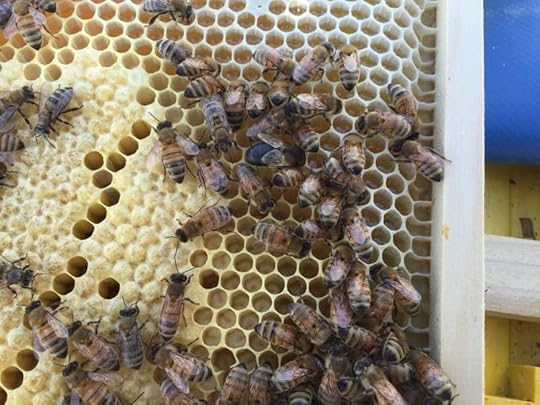Harry Stoddart's Blog
December 21, 2015
Manitoba Cooperator: Farming with a focus on restoration
The Manitoba Cooperator did an article on my presentation at the Manitoba Conservation Districts Association Annual Conference in Brandon earlier this month.
Farming with a focus on restoration

An experienced Ontario producer says implementing a holistic management plan would be a benefit
As many in the industry strive for sustainability, an experienced Ontario farmer wants to go one step further to build a farming system that does better than perpetuate itself.
“The term ‘sustainability’ has really come to mean less damaging than the alternative, rather than truly improving or repairing,” said Harry Stoddart, during a presentation at the Manitoba Conservation District Association’s 40th annual conference held in Brandon on December 8.
“I like the term ‘regenerative’ or ‘restorative.’ Essentially, the central concept in that is that we are not happy with the status quo. We are not talking about reducing our harm, we are looking for ways we can rebuild and restore.”
Drizzy and the Hen
This is a pic of on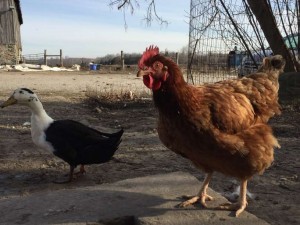 e of the odder couples at The Stoddart Family Farm. We came to have this drake when a predator got all a neighbour’s hens and left this poor fellow all alone. He settled right in with our hens and ducks. However, he decided this hen was his girlfriend – having always lived with hens I’m not sure he realizes that he is a duck. The hen is quite happy with the arrangement – there isn’t a rooster on the place that will come near her! We call him Drizzy (which will be meaningless unless you are familiar with Canadian rappers or Degrassi Street).
e of the odder couples at The Stoddart Family Farm. We came to have this drake when a predator got all a neighbour’s hens and left this poor fellow all alone. He settled right in with our hens and ducks. However, he decided this hen was his girlfriend – having always lived with hens I’m not sure he realizes that he is a duck. The hen is quite happy with the arrangement – there isn’t a rooster on the place that will come near her! We call him Drizzy (which will be meaningless unless you are familiar with Canadian rappers or Degrassi Street).
December 11, 2015
When did you stop beating the planet?
We’re reaching that time when our parent’s health is starting to decline. At some point we’ll likely have to make some decisions around assisted living. It’s not a decision I will make easily – the scandals in Ontario facilities around elder abuse are occurring a little too often. If I ever found out something was happening to either of my parents, I would have a “chat” with the manager – after he/she regained consciousness. The conversation wouldn’t be centered on how we can reduce the severity or frequency of the abuse, it would be focused on ending the abuse immediately and restoring my parent’s health. It’s black and white for me and, I assume, most of you.
Unfortunately, the folks meeting in Paris aren’t taking a similar view on the state of the health of our planet. Some Western countries (including Canada) want targets that are soft – they’ll make best efforts but don’t want any accountability if they miss their targets. It’s an approach that worked really well for Kyoto and Chretien – he got the photo op for signing the accord, his Environment Minister renamed his dog and then they quietly did nothing.
I have little faith in the international political process. But I do have faith in citizens. Together we can make choices to end the abuse of our planet. A single honeybee in its lifetime will produce about half a gram of honey. Each year, our hives produce between 50 and 100 kg of honey in addition to a number of pounds of wax. A hive is a group of individuals focused on a task that is greater than their lifetime – the bees that collect honey in the spring aren’t the same ones that will benefit from the honey stores in the winter. Humanity could learn a lot from the bee. It is going to take focus and a long term vision.
Here at The Stoddart Family Farm, we believe we are on a path to restoration – not just reduction of the destruction. You are an integral part of what we do – our “co-farmers” if you will. You choosing to purchase from us is a vote for “stopping the abuse” rather than “reducing the severity.” We thank you for your votes of confidence. It is humbling – you are entrusting not only the health of this piece of land to us but also your own health and the health of your family. We believe that is a sacred trust.
Thank you.
Harry and Silvia
October 4, 2015
What is “Good Enough”?
Some of you know that I am a faculty member at Fleming College in the Sustainable Agriculture program. I also guest lecture at other institutions. Last spring a colleague from the Flourishing Business Innovation Toolkit project and I were guest lecturers in the Strategic Foresight and Innovation Master’s program at OCADU. We had two classes to help the students understand and apply the Flourishing Business Canvas – a tool for designing businesses and organizations that will support the health of people and the planet over the long term.
Our tool is the first to explicitly put all necessary dimensions for design on one canvas on one wall. For the second class, the students used the canvas to describe a case study business of their choosing. One of the groups chose a social enterprise that sells solar powered lights as a replacement to kerosene lamps in Africa. On the surface it looks like they have covered all the angles – they have a local seller network to mitigate the impact on the local economy of displacing the kerosene supply chain, the lights are marketed globally with margins on lights sold in the developed world subsidizing the lights sold in Africa, and they have developed a low cost supply infrastructure direct from Southeast Asia. However, the canvas highlighted several areas where the business hadn’t thought through all the consequences. First, the solar lights were still being made in a take-make-waste paradigm – at the end of their useful life, the plastic, lights, solar cells and batteries were garbage. Second, the health of the people making the products in Southeast Asia weren’t being considered. Third, no life cycle analysis had been completed to determine whether the units were actually an energy source improvement over kerosene lamps (most argued that it was so obvious that the analysis didn’t need to be completed – they’re likely right but I’ve been fooled enough times to know that it is always worthwhile to complete the full analysis.)
For pointing this out, I was, for all intents and purposes, labled a privileged white hypocrite. Now, the label I have no issue with – I am privileged, white, and a hypocrite. So was almost everyone else in the room. I didn’t cede any moral ground on that point. The students were quite willing to sacrifice some health in SE Asia and add plastics and toxics to the environment in Africa in order to accomplish the goal of reducing the burns from kerosene lamps and increase the education level in Africa. It’s an “ends justify the means” argument blended with that special disdain for anyone from a developed society who suggests that less developed societies shouldn’t be allowed to screw up their section of the planet to the same degree we have in the name of raising their standard of living.
I think the root of our difference of opinion comes from our worldviews – the students believed that compromise was necessary – that we had no choice but to substitute environmental health for improving the standard of living in less developed parts of the world and since our society had done it, we had to allow others to do it. I don’t accept either premise. We now have the knowledge of what happens when we follow the compromise path and can easily deduce that it is the wrong path. We owe the rest of humanity the benefit of our knowledge. We also owe it to the rest of humanity to challenge ourselves to find the solutions that are without compromise, the solutions that stop our damage, the solutions that begin the healing.
The criticism I often receive is that I am aiming too high – that perfection is the enemy of good. But good is the enemy of great. The boundaries for a great solution can be defined. But a “good” solution always leaves the question “is it good enough?” The answer is “no” until the solution becomes great. Here at the farm we have a goal of using agriculture to regenerate the planet and create a flourishing future for all living things. Are we there? No. But anything less than this goal would require compromise.
We’ve been a little quiet…
You may have noticed that it has been a while since I last posted – it’s been an eventful summer. The two big events were 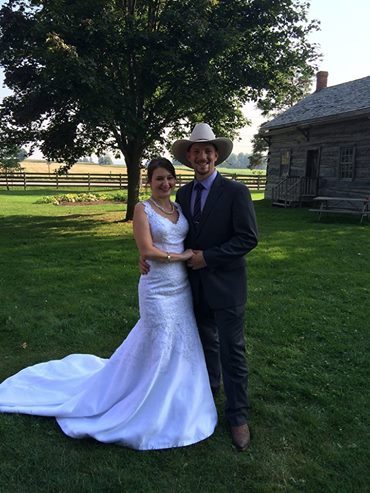 THE WEDDING and THE STORM. Our oldest son, Connor married the love of his life, Rebecca (yes, there is now a Rebekah Stoddart [daughter] and a Rebecca Stoddart [daughter-in-law]) on Labour Day Weekend. The wedding was on the grounds of a small pioneer museum not too far from the farm. It was a whirlwind weekend with both Silvia’s sister visiting from Australia and my sister and her family visiting from Nova Scotia.
THE WEDDING and THE STORM. Our oldest son, Connor married the love of his life, Rebecca (yes, there is now a Rebekah Stoddart [daughter] and a Rebecca Stoddart [daughter-in-law]) on Labour Day Weekend. The wedding was on the grounds of a small pioneer museum not too far from the farm. It was a whirlwind weekend with both Silvia’s sister visiting from Australia and my sister and her family visiting from Nova Scotia.
THE STORM was an unwelcome visitor on the August long weekend. We took some serious damage to two buildings – our tarp building and our main farm shop. Thankfully, no one was hurt and we only lost a couple of chickens and a couple of turkeys – despite both their pasture pens being shifted a number of feet. The tarp was replaced last weekend (Yay! – I now can park my equipment under a roof again). The boys and I are working at taking the big shed down for it to be rebuilt. We’ve emptied it. Removed the electrical and air lines. Removed all the steel from the interior walls. Removed 100 yards of blown in insulation from the attic and all the insulation batts from the walls. This week steel starts coming off the outside.
June 12, 2015
Open House Tomorrow – June 13th
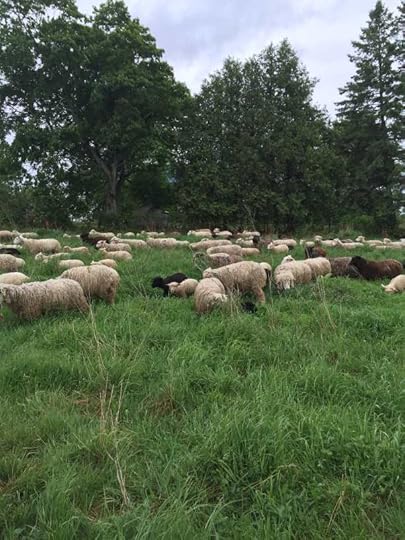 All 560 acres and all the cattle and sheep have been well washed and are ready for your visit tomorrow (the pigs on the other hand have been loving the rain for a completely different reason – everyone gets their own puddle!). Visit between 1 and 4 to get a guided tour of the Real Dirt. Store will be open for fibre and meat purchases.
All 560 acres and all the cattle and sheep have been well washed and are ready for your visit tomorrow (the pigs on the other hand have been loving the rain for a completely different reason – everyone gets their own puddle!). Visit between 1 and 4 to get a guided tour of the Real Dirt. Store will be open for fibre and meat purchases.
June 5, 2015
Recent Pics from around the Farm
April 23, 2015
Why we’ve decided to drop organic certification
We produced a certified organic crop for the first time 17 years ago in 1998 – organic food grade white hilum soybeans. A decade later, a partner and I were running 2000 acres of certified organic land. The land on our current farm was completely certified in 2009. However, we are now at an interesting cross-roads, our land is certified organic but none of our products are since we don’t certify our animals.
When we started meat production, the home farm was in transition and we were growing hay and pasture as our transitional crop and therefore our cattle and sheep couldn’t be certified. We were buying weaner pigs and raising them at that time and couldn’t find a local source of certified organic weaner pigs, so we couldn’t certify our pork. We did certify our poultry for a year but when we surveyed you (our customers) about what was most important to you about our meat, certified organic was well down the list. 100% grassfed, humane, and pastured were much more important. So we decided not to certify once we could have. Ironically, for several years we were growing certified organic grain and feeding it to our non-certified pigs and poultry. Our cattle and sheep graze organic pastures and are fed mostly organic hay in the winter (some years we have to purchase hay to supplement our own production). Each year our inspector asks why we don’t certify when what we do generally meets the organic standard. Our answer is time and money. The record keeping required for each individual animal is greater than what we currently do, plus our certification fee would increase significantly (it’s already around $1400). I doubt that having “certified organic” meat would add much value for you (our customers) and therefore, we wouldn’t be able to justify raising our prices to cover the increased costs.
Silvia and I have been mulling over dropping the certification on our land for a couple of years. I’ve been reluctant – I’ve had certified organic land almost as long as I have been farming. “Organic” has been the one consistent label I’ve identified with for most of my farming career. I’ve been at it long enough that I was called a “pioneer” of the Ontario Organic movement recently, but we hardly fit that definition – we stood on the shoulders of people who had been at it for 20 years when we started. Part of my reluctance is the stigma I will feel (whether it is there or not) when I’m at Organic events but I will no longer be a certified Organic farmer. So what? I’ve always argued that if you weren’t certified, you weren’t Organic. I will have separated from my “tribe”. Dropping the certification doesn’t mean anything in our philosophy or management will change, we just won’t be paying someone to look at our paperwork once a year and pronounce it good. Instead, you, our customers will be welcome to inspect our practices. Our first open house in a few years is happening on May 23 from 1-4. Come out and see for yourself what we’re up to.
Our mission is still “To use agriculture to regenerate the planet and create a flourishing future for all living things.” We’ve decided that we can accomplish more with that $1,400+ each year using it for something other than certifying our land. If you have any questions, please do not hesitate to call us. And remember – our animals are NOT on drugs…just grass.
April 19, 2015
It’s been a busy week of coverage for Rent The Chicken
Here’s a sampling of the media coverage our new businesses – Rent The Chicken and Hatch The Chicken - have received in the first two weeks of April:
Rent the Chicken runs a-fowl of Toronto bylaw | Toronto Star.
The Most Free Range Chickens You Will Ever Meet | TujaWellness.com
Urban Egg Lovers Skirt Bylaws with Rental Chickens | The Globe and Mail
Little Britain Farm Ruffling Some Feathers | Peterborough Examiner
Backyard Chicken Movement Pushes for Change | Toronto Sun
Fresh Eggs Are Great. But at What Cost? | AM 640
March 8, 2015
What You Can’t Say in 140 Characters or Less.
Yesterday I had an active day on Twitter and in reviewing some of the comments the threads attracted, I can see that the limitations of Twitter left out many of the nuances of my tweets. First off, Terry Daynard and I have known each other personally for almost 30 years. I’ve sat at his kitchen table discussing issues on more than one occasion. I’ve also known most of the staff at Farm and Food Care since our university days. Nothing I tweeted yesterday should have been interpreted as an ad hominem attack.
What initiated my tweeting was Terry’s piece on neonicotinoids in the National Post as part of their “Junk Science” week. While I’m not convinced that neonics are directly responsible for CCD, I’m not ready to dismiss the possibility that they are a contributing factor and I definitely wouldn’t label the connection as “Junk Science.”
There were two items in particular in the article that irked me. One of the common defenses for neonics is that poor beekeeper management is responsible for CCD, not neonics. This tone has been used throughout the discussions this winter – that somehow, beekeepers in Ontario are a bunch of hobbyists who lack the proper skills to keep hives alive (as opposed to beekeepers in Western Canada who have no trouble keeping their bees alive). Are there hobbyist beekeepers in Ontario? Yes. Are there also professional beekeepers who derive all or a significant portion of their income from beekeeping? Yes. To write off the entire CCD problem under a stereotype of incompetence on the part of fellow individuals within agriculture is offensive.
Terry also dismissed the European study that supported the moratorium on neonic sales in the EU as having “cherry picked” 800 studies that supported the scientists’ views. He then pointed out that a subsequent review of 1 500 studies came to a different conclusion. This situation reminds me of an anomaly in the Scottish legal system that allows for three verdicts – Guilty, Not Proven, and Not Guilty. Science has a lot of “Not Proven” conclusions. Not Proven isn’t necessarily Not Guilty. Even if the two reviews Terry references contained no overlap, one third of the studies looking at the connection between neonics and bee mortality concluded there is cause for concern. This hardly qualifies as “Junk Science.” Implicit in Terry’s comments was an assertion that the European regulatory authority was duped by a conspiracy of scientists. That another regulatory agency takes a different approach and reaches different conclusions than their North American counterparts doesn’t make their decisions wrong. It also doesn’t mean they are incompetent.
My tweets included a second line of comment that related to one of Terry’s previous tweets regarding the non-ag influence on the Minister’s actions on the neonic and other issues. The Ontario ag industry needs to understand that eaters and citizens of Ontario believe that they should have some say in agri-food policy. That an urban-based government gives weight to eaters’ opinions should not be surprising. Because they were blindsided by the neonic decision, the Grain Farmers of Ontario refused to participate in the Ministry’s consultation process. The Minister and Ministry were acting on the direct instructions of the Premier as revealed in the Premier’s Mandate Letter to the Minister. Attempting to embarrass the Minister is a foolhardy strategy when it is clear that the Minister has the support of the Premier and Cabinet. Piling on by labeling the decision as junk science in a national newspaper was ill considered. The ag industry needs a good working relationship with the Minister.
Ontario agriculture likes to congratulate itself on its forward thinking with initiatives such as the Environmental Farm Plan and the work of organizations such as Farm and Food Care. These initiatives were a start and have had a positive impact but they fall far short of what is needed on the environmental front to neutralize the negative impacts of agriculture. These approaches are losing effectiveness in today’s political environment. The cynicism of the public towards information defending the practises of an industry provided by industry funded organizations has never been higher and continues to rise. That Monsanto, DuPont et al partially fund Farm and Food Care activities immediately discredits them with many people in the food movement. Ontario agriculture needs a new approach.
There are more people than ever trying to engage with and influence their food system. Ontario agriculture can continue defending the status quo or it can choose to work with eaters to build a shared vision of a future with a food system that heals Ontario and its citizens.

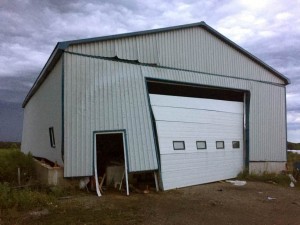
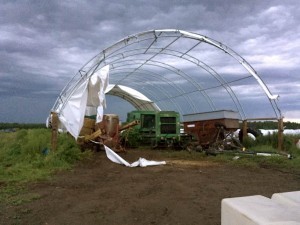
![IMG_0496[1]](https://i.gr-assets.com/images/S/compressed.photo.goodreads.com/hostedimages/1433677745i/15129789._SX540_.jpg)
